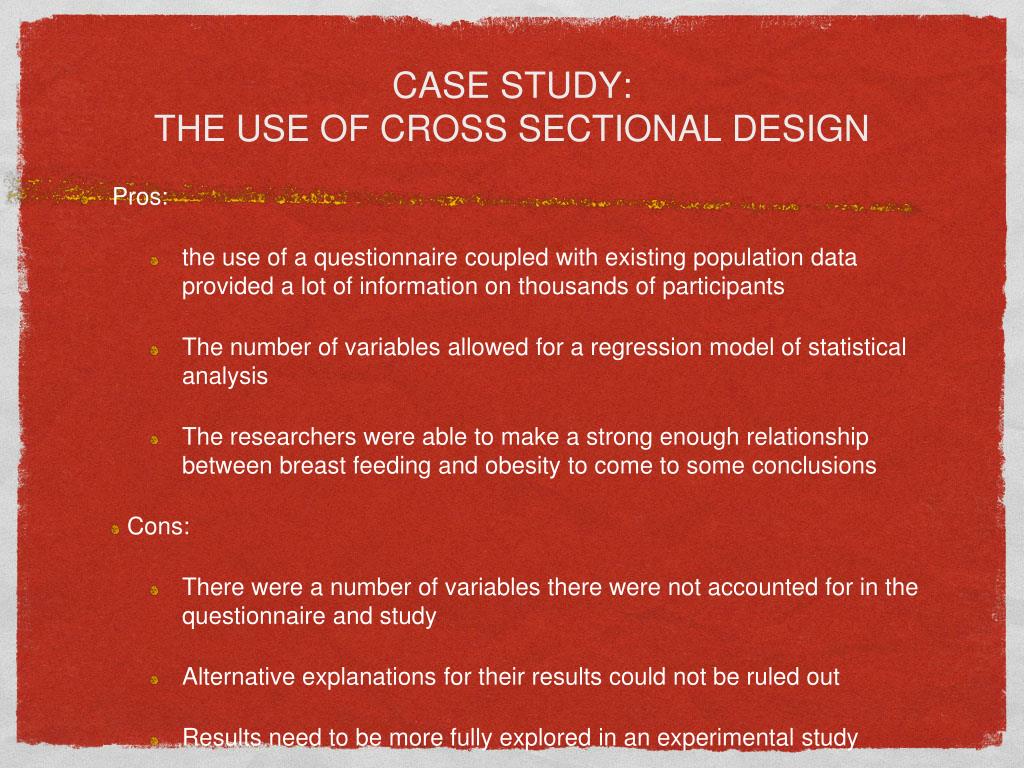Table Of Content

Because all of the variables are analyzed at once, and data does not need to be collected multiple times, there will likely be fewer mistakes as a higher level of control is obtained. Westat used the disposition results to compute response rates consistent with AAPOR definitions. The response rates are weighted by the base weight to account for the differential sampling in this survey. The AAPOR RR3 response rate to the screening interview was 17.0%.2 The RR1 response rate to the extended Asian American interview (77.9%) is the number of eligible adults completing the questionnaire over the total sampled for that extended questionnaire. The overall response rate is the product of the screener response rate and the conditional response rate for the extended questionnaire. The overall response rate for the Asian American sample in the Pew Research Center survey was 13.3% (17.0% x 77.9%).
Defining Characteristics of Cross-Sectional Studies
The people in that extended family are used to determine what is happening in real-time at the moment. The majority of research designs in psychology are cross-sectional designs as defined above. Typically, however, they are only explicitly referred to as such when contrasted with longitudinal designs. Cross-sectional studies are a crucial tool in the repertoire of research methodologies, offering unique advantages that make them particularly suitable for various research contexts. These studies are instrumental in providing a snapshot of a specific point in time, which can be invaluable for understanding the status quo and informing future research directions.
Benefits of cross-sectional studies
According to Cummings et al., 2013, determining which variable to label as dependent or independent “depends on the cause-and-effect hypotheses of the investigator” (p. 85) or the biological plausibility rather than on the study design. Longitudinal studies and cross-sectional studies are two different types of research design. In a cross-sectional study you collect data from a population at a specific point in time; in a longitudinal study you repeatedly collect data from the same sample over an extended period of time.
Create and Analyse a Cross-Sectional Study Survey
Monitoring of antibiotic use and resistance patterns underpin the effective implementation of AMS interventions in combatting AMR [20]. To date, few studies have assessed antibiotic use and antimicrobial resistance pattern in secondary referral hospitals in Malawi. In comparison with tertiary hospitals, secondary hospitals have inadequate staff and fewer resources to support precise diagnosis and rational use of antibiotics. However, there is limited data to provide insights on the antibiotic medicine related problems in secondary hospitals in Malawi. This retrospective study investigated frequency of antibiotics use and resistance pattern at Rumphi district hospital, a secondary referral facility In Malawi.
Performance investigation and parameter identification of inverse variable cross-section energy harvester - ScienceDirect.com
Performance investigation and parameter identification of inverse variable cross-section energy harvester.
Posted: Thu, 15 Jun 2023 07:00:00 GMT [source]
This lack of experience may have limited their ability to understand students’ experiences in simulation situations, which, in turn, affected their ability to provide students with the support they needed during simulation. 1) The general characteristics of the participants, simulation design, flow, and simulation educational satisfaction were calculated as frequencies and percentages and means and standard deviations. The NLN/Jeffries theory of simulation [14] explains that within the overall context of simulation-based education, simulation design influences the simulation experience, resulting in simulation-based education outcomes. During the debriefing process, learners who participated in the simulation acquire knowledge and skills about the simulation situation and can learn through reflection [7]. Well-designed simulation-based education improves clinical decision-making, promotes learning engagement, and increases satisfaction and confidence in learning [15,16,17].
In contrast, longitudinal research takes considerable time because data is collected across numerous periods (potentially decades). Longitudinal studies tend to require more resources; these are often more expensive than those used by cross-sectional studies. They are also more likely to be influenced by what is known as selective attrition, which means that some individuals are more likely to drop out of a study than others. Because a longitudinal study occurs over a span of time, researchers can lose track of subjects. Individuals might lose interest, move to another city, change their minds about participating, etc.
Frequently asked questions about cross-sectional studies
A cross sectional study conducted among households in densely populated townships in Malawi revealed high usage of antibiotics such as Amoxicillin, Erythromycin and Cotrimoxazole [12]. These are among antibiotics with diminished effectiveness reported in many studies on antimicrobial resistance pattern in Malawi and sub-Saharan region [13, 14]. As reported by the Global Research on AntiMicrobial resistance (GRAM), In 2019 alone, Malawi registered about 3600 deaths attributable to AMR [15]. This signifies the burden of bloodstream infections that pose a challenge to treat especially in resource-limited setting. At Rumphi district hospital, AMR has led to an upsurge of clinical failures with a third of clients with sexually transmitted infections (STI) returning to the facility after failing to respond to first line antibiotic treatment.
Participants
A cross-sectional study involves gathering and analyzing data from a population of interest at one specific point in time. Typically, the researcher is conducting the study to describe the characteristics of the population, or to explain the relationship between a particular outcome and some other variable(s) of interest. Educational researchers often use a cross-sectional design to evaluate student performance across different grades or age groups at a single point in time.

Cross-Sectional Study: What it is + Free Examples

Therefore, even where the research design is explanatory in nature, it is not possible to determine the direction of causality between pairs of variables. Cross-sectional studies are what researchers call observational studies (as distinct from experimental type studies). This means that researchers do not manipulate variables, and they don’t assign different cohorts in a sample to different study groups. Instead, the researcher simply records the information they observe within a population.
In our study, we further observed less commonly used vancomycin and chloramphenicol antibiotic performing much better against some resistant bacterial strains. This is in an agreement with other studies that found chloramphenicol maintaining its efficacy against eye infections compared to tetracyclines and floroquinolones [28]. Although most facility no longer use such drugs over the growing concern of toxicity, randomized controlled trials (RCTs) have demonstrated that such antibiotics are as safe as treatment alternative for short antibiotic courses [29].
As discussed in the earlier articles, we have highlighted that in an observational study, the investigator does not alter the exposure status. The investigator measures the outcome and the exposure(s) in the population, and may study their association. A cross-sectional study is a type of research design in which you collect data from many different individuals at a single point in time.
A prospective study conducted at Kamuzu central hospital in Malawi reported resistance to several first line antibiotics for treating bacteremia and other life threatening infections [10]. The resistance patterns observed in central hospitals may not be the same compared with secondary referral facilities as the treatments and as well as the infection control and prevention practices greatly vary. However, of the commonly used antibiotic in both central and secondary hospitals in Malawi are third generation cephalosporins whose resistance rates are reportedly high [12]. Resistance to cephalosporins present a big challenge as they are used as first line and last line antibiotics in many secondary health facilities in Malawi. We used a cross-sectional study design in which records of patients data on culture and antimicrobial sensitivity tests were extracted, alongside treatment history from 2019 to March, 2023, retrospectively. We also included findings for point prevalence survey (PPS) conducted within four hospital wards in June, 2022 by a well-trained multi-disciplinary team from within the hospital.
The guideline is a tool investigators can use to develop their manuscripts and offers a checklist of inclusion items for a published paper (Equator.network). The recommended items will help ensure that a reader can understand the manuscript, follow the study’s planning and how the research was conducted, the findings, and the conclusions (von Elm et al., 2014). A cross-sectional study is a cheap and easy way to gather initial data and identify correlations that can then be investigated further in a longitudinal study. Researchers in economics, psychology, medicine, epidemiology, and the other social sciences all make use of cross-sectional studies in their work. For example, epidemiologists who are interested in the current prevalence of a disease in a certain subset of the population might use a cross-sectional design to gather and analyse the relevant data. The second step in the weighting process was adjusting the base weight to account for occupied households among those with unknown eligibility (category 4).
All people have at least one variable in common – being related – and multiple variables they do not share. This study type is also known as cross-sectional analysis, transverse study, or prevalence study. Although this research does not involve conducting experiments, researchers often use it to understand outcomes in the physical and social sciences and many business industries. You might find that as respondents’ concern for their health increases, the amount of time spent vaping decreases. In other words, you will not be able to tell from a cross-sectional research study whether being more concerned about your health reduces the amount of time spent vaping, or whether in fact, people who vape less become healthier. For example, if you are interested in learning whether privacy concerns differ among people who primarily shop online versus those who primarily shop at brick and mortar stores, you would simply gather that information, as well as any other variables of interest.
Overall, cross-sectional studies can be a valuable tool for researchers looking to understand a population quickly. Typically, the type of analysis that is performed when using a cross-sectional research design is a correlational analysis, which seeks to determine whether there is a relationship between two variables, and what the nature of that relationship is. For example, let’s say you’re interested in whether there is a relationship between concern with health and the amount of time spent vaping among users of vape products. Cross-sectional studies do not manipulate variables and, therefore, cannot determine cause-and-effect relationships.

No comments:
Post a Comment